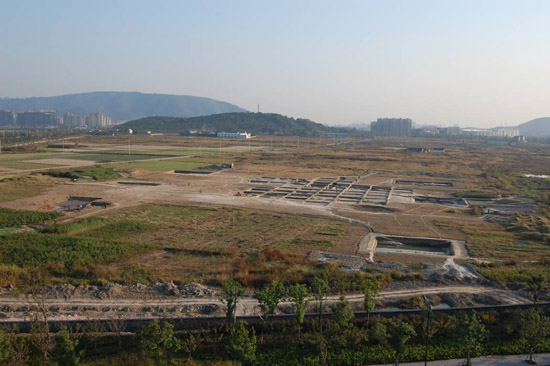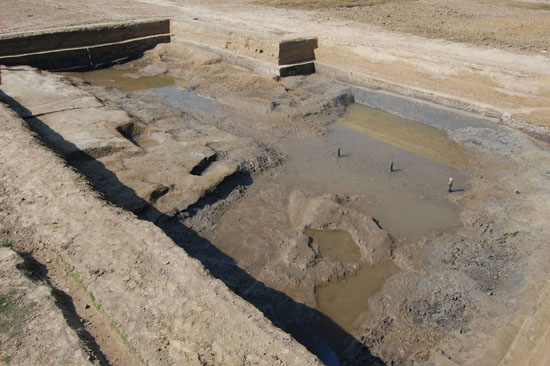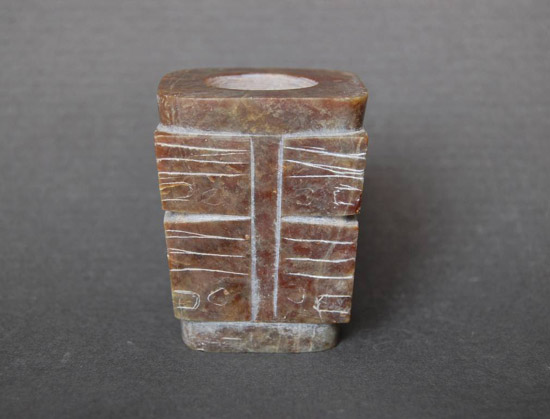Settlement of the Liangzhu Culture with Surrounding Ditch at Yujiashan, Yuhang, Zhejiang
The Yujiashan site is located to the north of the Fenghe Village, Lingping Community, Yuhang District of Hongzhou City. About 20 km east to the famous Liangzhu site complex, the site is nearly 2.5 ha in size. The Zhejiang Provincial Institute of Archeology and Cultural Relics and the Yuhang Museum conducted a salvage excavation at the site in October 2008. Within the 7600 sq m excavated area, a settlement of the middle and late Liangzhu culture with a surrounding ditch was discovered, together with a large piled earth platform, “sandy layers”, burials, dwellings, pits and rice paddy. Another excavation was launched in November 2009 to get a section of the ditch. By present, some 139 burials, 8 pits, 2 dwellings have been unearthed. The excavation is still undergoing.

Coring and excavation indicate that the site is square in shape and surrounded by a ditch. A earth platform are discovered within the ditch. Excavations and coring at the four corners and eastern, southern and western parts of the ditch show that the ditch has a square outline with its middle northern part lightly convex. Length of the four sides of the ditch is between 134 to 155 meters, 4.45 to 15.2 meters wide and 0.6 to 1.25 deep. The ditch might have been dug in middle Liangzhu probably for the construction of earth platform within in and abandoned in late Liangzhu.
The earth platform which is 1.35 m at the thickest part, is lightly smaller than the area surrounded by the ditch. By present, only burials at the top of the platform had been unearthed.

The two flat-top “sandy layers” are man-made matrix of rock power, small pebbles and clay. The “sandy layer I” near the center of the earth platform is 70 m from east to west, 7.8 to 18 m from south to north, 1000 sq m in size and 0.15 m in thickness. Some post pits were found on it. The “sandy layer II” at the southeastern part of the earth platform is square in shape, 8 to 10 m in side length, 0.15 m in thickness and 80 sq m in size. A sandy ware urn was found in it. The “sandy layer I” is different from dwelling foundation and the hard surface of a special area for general activities. It might be a platform for ritual practice pertaining to the burials to its south and north.

Cemetery of the site is divided into the southern and northern parts by the “sandy layer I” in the middle. By present, 139 burials have been excavated and there might be still more than ten burials kept untouched. All of the burials belong to the middle and late Liangzhu periods, while late Lianzhu burials take a higher percentage. All the unearthed burials have a rectangular burial pit. Most of the decease headed to the south, a few to the north. Skeletons are in bad condition, and mainly in extended supine position. Some secondary burials can be recognized. Remains of coffins was found in several burials. About 1300 pieces (sets) of ceramic, stone and jade objects were unearthed from the burials. Main pottery types include the ding tripods, dou stemmed-plate, guan pot, zun vessel, plate, basin, gui vessel, double-knobs hu pot and spindle wheel. The ding tripods, dou stemmed-plate, guan pot ( zun vessel) is the basic set of ceramic offerings. Main types of jade objects include the cong tube, bi disk, coronet -shaped comb body, huang pendant, bracelet, ring, fork-shaped object, end decoration, spindle wheel, awl-shaped objects and a large number of small tubes and beads. Main types of stone objects include the yue axe and arrowhead. Other burials offerings include lacquer objects, boar tusks and shark teeth. Burial M20 which has 45 pieces (sets) of offerings is the richest burial. Two burials have no offerings.

All the four high-status burials with jade cong tubes and bi disks concentrate at the northeast part of the northern cemetery. Importantly, a bi disk which is 24.7 cm in diameter and has two curved symbols on the top and side was found in burial M16. This is the first jade bi disk with curved symbols found in archaeological context, and the largest bi disk ever unearthed in Zhejiang. Curved designs on the cong tube in burial M21 is careless.
The “rice paddy” was discovered on the top of the ditch. It is a kind of black and gray-black soil covering a more than 1 ha area mainly outside the ditch. Analysis of soil samples from the paddy shows a high percentage of rice phytolith.
The discovery of the ditch surrounded Yujiashan settlement is a significant event in the prehistory archaeology in Zhejiang. Considering other archaeological evidence found in recent years, we believe that there might be a large settlement complex in the areas to the west and north of the Linping Mountain.

